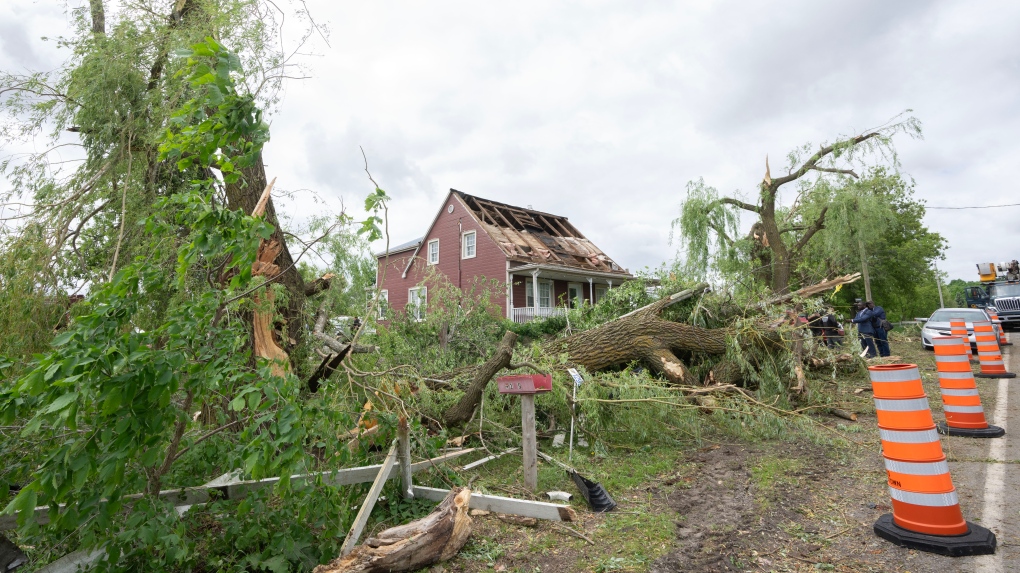Was that a tornado? Basic guide to identificaiton
On Wednesday night, Environment and Climate Change Canada and the Northern Tornadoes Project (NTP) at Western University confirmed that Ontario and Quebec were hit by at least four tornadoes.
NTP Executive Director David Sills explained that this week's tornadoes were quickly confirmed because teams had video evidence clearly showing a tornado causing damage.
"Last night, there was evidence both in Ontario and Quebec of a tornado based on video," he said. "It was backed up by radar, and also people on the ground reporting damage. So we didn't have too much of a problem confirming tornadoes in Ontario, Quebec last evening."
Violently rotating column of air
To be classified as a tornado, the funnel cloud must be travelling at least 90 km/h, which shows evidence that it could produce damage.
"Basically, it's a rotating column of air that's connected to the cloud base and connected to the ground, and has damaging winds associated with it," said Sills.
 Storm damage is seen in Tres-Saint-Redempteur, Quebec on Tuesday, May 28, 2024 after a suspected tornado went through yesterday evening. (Ryan Remiorz/The Canadian Press)
Storm damage is seen in Tres-Saint-Redempteur, Quebec on Tuesday, May 28, 2024 after a suspected tornado went through yesterday evening. (Ryan Remiorz/The Canadian Press)
Environment Canada uses the Enhanced Fujita (EF) scale, which goes from EF rating 1 (90-130 km/h) to 5 (315 km/h or more).
"The EF-scale employs a large number of damage indicators, ranging from residential housing to office towers to trees," Environment Canada says. "Wind speeds are more accurately related to wind damage thanks to an expert elicitation process that involved the meteorological, engineering and architecture communities."
Tornado or a downburst
Sills said the first thing teams need to do is make sure the phenomenon is not something else.
"A lot of times, when we get reports of damage, the first thing we need to do is determine if it was a tornado or a downburst that caused the wind damage," he said. "The patterns that are produced by those two different phenomena are quite different."
In a tornado, the wind is coming in towards the bottom of the storm and travelling up.
 Multiple homes have been damaged as a tornado appears to have touched down in Rigaud, Que. (Baradaran Glady)
Multiple homes have been damaged as a tornado appears to have touched down in Rigaud, Que. (Baradaran Glady)
A downburst is the opposite: the wind starts at the top and spreads out when it hits the ground.
"You've got one pattern that's kind of a converging pattern, and usually you get a narrow, long path with a tornado, whereas with a downburst it's a diverging path, so all the trees or whatever are pushed out from a central point," he said.
The NTP says most showers and thunderstorms produce downbursts and that these can interfere with aircraft taking off or landing.
CTVNews.ca Top Stories

Trudeau's 2024: Did the PM become less popular this year?
Justin Trudeau’s numbers have been relatively steady this calendar year, but they've also been at their worst, according to tracking data from CTV News pollster Nik Nanos.
Calling all bloodhounds: These P.E.I. blood donors have four legs and a tail
Dogs are donating blood and saving the lives of canines at the University of Prince Edward Island's Atlantic Veterinary College in Charlottetown.
London Liberal MP's say that Trudeau is taking time to reflect on the future of the party
Both of London’s Liberal MP’s are choosing their words carefully when it comes to their party's leadership future. They were asked about the situation in Ottawa at Friday's housing announcement in London.
Wild boar hybrid identified near Fort Macleod, Alta.
Acting on information, an investigation by the Municipal District of Willow Creek's Agricultural Services Board (ASB) found a small population of wild boar hybrids being farmed near Fort Macleod.
Manhunt underway after woman, 23, allegedly kidnapped, found alive in river
A woman in her 20s who was possibly abducted by her ex is in hospital after the car she was in plunged into the Richelieu River.
New rules clarify when travellers are compensated for flight disruptions
The federal government is proposing new rules surrounding airlines' obligations to travellers whose flights are disrupted, even when delays or cancellations are caused by an "exceptional circumstance" outside of carriers' control.
Summer McIntosh makes guest appearance in 'The Nutcracker'
Summer McIntosh made a splash during her guest appearance in The National Ballet of Canada’s production of 'The Nutcracker.'
A 9-year-old is among 5 killed in the Christmas market attack in Germany
A nine-year-old was among five people killed when a Saudi doctor intentionally drove into a Christmas market teeming with holiday shoppers in the German city of Magdeburg, an official said Saturday.
Toronto firefighters rescue man who fell into sinkhole in Yorkville
A man who fell into a sinkhole in Yorkville on a snowy Friday night in Toronto has been rescued after being stuck in the ground for roughly half an hour.


































